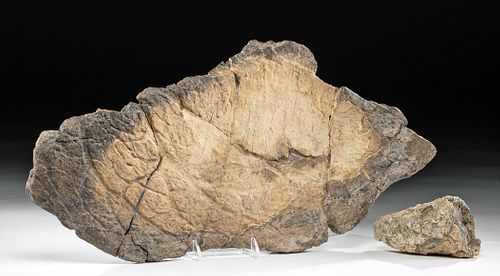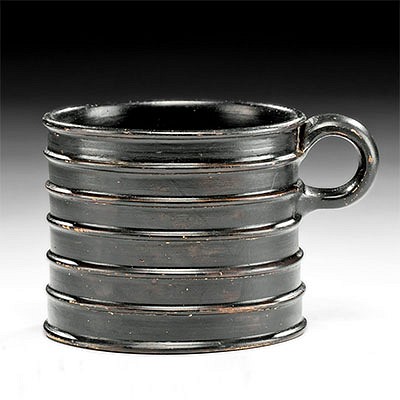Lot of 2 Triceratops Fossils - Horn Tip, Frill Fragment
Lot 93g
About Seller
Artemis Fine Arts
686 S Taylor Ave, Ste 106
Louisville, CO 80027
United States
Selling antiquities, ancient and ethnographic art online since 1993, Artemis Gallery specializes in Classical Antiquities (Egyptian, Greek, Roman, Near Eastern), Asian, Pre-Columbian, African / Tribal / Oceanographic art. Our extensive inventory includes pottery, stone, metal, wood, glass and textil...Read more
Categories
Estimate:
$1,600 - $2,400
Absentee vs Live bid
Two ways to bid:
- Leave a max absentee bid and the platform will bid on your behalf up to your maximum bid during the live auction.
- Bid live during the auction and your bids will be submitted real-time to the auctioneer.
Bid Increments
| Price | Bid Increment |
|---|---|
| $0 | $25 |
| $300 | $50 |
| $1,000 | $100 |
| $2,000 | $250 |
| $5,000 | $500 |
| $10,000 | $1,000 |
| $20,000 | $2,500 |
| $50,000 | $5,000 |
| $100,000 | $10,000 |
| $200,000 | $20,000 |
About Auction
By Artemis Fine Arts
Mar 12, 2020
Set Reminder
2020-03-12 10:00:00
2020-03-12 10:00:00
America/New_York
Bidsquare
Bidsquare : Ancient / Ethnographic Around The World
https://www.bidsquare.com/auctions/artemis-gallery/ancient-ethnographic-around-the-world-4957
Ancient art from Egypt, Greece, Italy and the Near East, as well as Asian, Fossils, Pre-Columbian, Native American, African / Tribal / Oceanic, Spanish Colonial, Russian Icons, Fine art, much more! Artemis Fine Arts info@artemisfinearts.com
Ancient art from Egypt, Greece, Italy and the Near East, as well as Asian, Fossils, Pre-Columbian, Native American, African / Tribal / Oceanic, Spanish Colonial, Russian Icons, Fine art, much more! Artemis Fine Arts info@artemisfinearts.com
- Lot Description
North America, late Cretaceous Period, ca. 68 to 66 million years ago. Wow! A pair of incredible fossils from triceratops (Triceratops horridus), one of the classic, best-known dinosaurs. First, the tip of a horn, and second, part of the massive facial frill. These large horned animals were initially mistaken by fossil hunters for a form of bison before they realized they were a type of dinosaur known as a ceratopsian. The triceratops skull was heavy and distinctive: with three horns, a parrot-like beak, and a frill that could reach three feet wide, it was one of the largest skulls known from any land animal. Size of frill fragment: 19" W (48.3 cm)
Interestingly, most horned animals travel in herds, but triceratops has been found more frequently in individual contexts. Puncture marks on the fossil frills of males of the species shown that they used their horns to fight each other, with some paleontologists believing that this was done to impress females. Finds of blood vessels throughout the horns and frills of these animals suggest that they were not just weapons, but were also used for identification of individuals, much like the antlers and horns of modern species like reindeer and mountain goats. These horns grew throughout the life of the animal, especially in childhood and adolescence, along with the skull, which went from one foot long in babies to six feet long in adults.
Provenance: private J.H. collection, Beaverton, Oregon, USA, acquired between 2006 (frill fragment) and September 2009 (horn tip); (frill fragment) ex-private collection; (horn tip) ex-private Webster, Texas, USA collection
All items legal to buy/sell under U.S. Statute covering cultural patrimony Code 2600, CHAPTER 14, and are guaranteed to be as described or your money back.
A Certificate of Authenticity will accompany all winning bids.
We ship worldwide and handle all shipping in-house for your convenience.
#153824Both items are fragments of a larger part of the body, as discussed above. The horn tip has excellent deposits on its surface. The frill fragment has been repaired from several large pieces.Condition
- Shipping Info
-
All shipping is handled in-house for your convenience. Your invoice from Artemis Gallery will include shipping calculation instructions. If in doubt, please inquire BEFORE bidding for estimated shipping costs for individual items.
-
- Buyer's Premium



 EUR
EUR CAD
CAD AUD
AUD GBP
GBP MXN
MXN HKD
HKD CNY
CNY MYR
MYR SEK
SEK SGD
SGD CHF
CHF THB
THB














